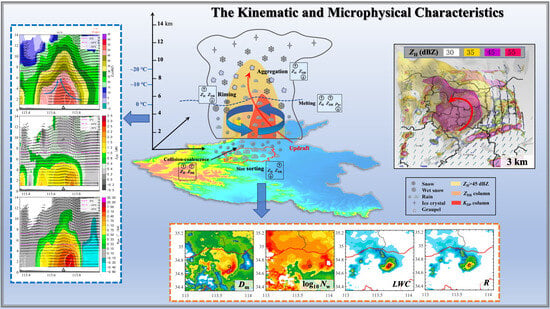The Kinematic and Microphysical Characteristics of Extremely Heavy Rainfall in Zhengzhou City on 20 July 2021 Observed with Dual-Polarization Radars and Disdrometers
Abstract
:1. Introduction
2. Data, Methodology, and Study Area
2.1. Polarimetric Radar Observations and Data Processing
2.2. Surface Disdrometers
2.3. DSD Retrieval with Polarimetric Radar
3. Results
3.1. Case Description and Synoptic Conditions
3.2. Mesoscale Structural Features in Extreme Heavy Precipitation
3.3. Characteristics and Evolution of the Three-Dimensional Fine-Scale Kinematic Structure in Extreme Heavy Rainfall
3.3.1. Horizontal Structural Characteristics
3.3.2. Vertical Structural Characteristics
3.3.3. Three-Dimensional Structural Characteristics
3.4. Microphysical Structure and Evolution of Extreme Heavy Rainfall
3.4.1. Polarimetric Radar-Based QVP Retrieval
3.4.2. Surface Disdrometer Observations
3.4.3. Radar-Retrieved DSD and Characteristics
3.5. Conceptual Model
4. Discussion and Conclusions
- From a circulatory background perspective, the conditions for extreme rainfall in Zhengzhou are similar to those of a warm-sector downpour. The abnormally northward-shifted West Pacific subtropical high and Typhoon In-fa transported a large amount of warm, moist air from the sea to the Zhengzhou region. Converging low-level airstreams on the eastern, southern, and northern sides of Zhengzhou contributed to the maintenance and development of this quasi-stationary storm, causing it to stall over the area. Additionally, the barrier effect of the Taihang Mountains to the north prompted the easterly winds to be deflected southward, converging with airflows from the south over Zhengzhou. The moisture transported by the southeastern boundary layer jet also accumulated in front of the mountains, providing favorable conditions for the development of the persistent precipitation system, leading to record-breaking extreme hourly rainfall in Zhengzhou;
- In terms of the FY-2G TBB and radar echo structure, the afternoon to evening of 20 July was the development phase of the MCC. The RBEHR in Zhengzhou from 16:00 to 17:00 BT primarily occurred during the merger of meso- and small-scale cloud clusters, and the merging of these clusters contributed to the increase in rainfall;
- Regarding the three-dimensional fine-scale kinematic characteristics, during the RBEHR period, a super low-level jet from the southeast was maintained, showing significant vertical wind shear. Low-level convergence and upper-level divergence favored the vertical ascent of air. From 16:00 to 17:00 BT, there was a considerable mesoscale vortex and convergence structure, causing the echoes to remain relatively stationary and the precipitation to revolve locally, resulting in localized extreme rainfall in Zhengzhou. Among the polarimetric variables, there were evident ZH columns, ZDR columns, and KDP columns corresponding to vertical updraft. Combined with the fine wind field and vertical vorticity information, the formation mechanism of the prominent ZDR arc feature in the polarimetric variables at this stage was revealed;
- Considering the strong localized nature of this extreme heavy rainfall event, we quantitatively analyzed its microphysical structure and evolutionary characteristics using radar-retrieved QVPs, DSDs, and surface disdrometer data. The results showed that the DSD type during the RBEHR period differed from that at other times and was primarily characterized by warm rain processes. Effective collision–coalescence processes led to the formation of high concentrations of raindrops with medium to large diameters, which predominantly contributed to extreme surface rainfall. The particle diameter observed by the surface disdrometer was larger than that determined by the low-level (1.5 km altitude) radar, whereas the particle concentration was lower. This suggests that during their descent, raindrops underwent significant collision–coalescence processes, resulting in an increase in the particle diameter and a decrease in the particle concentration by the time they reached the ground.
Author Contributions
Funding
Data Availability Statement
Conflicts of Interest
Appendix A
Appendix A.1. Interpolation of Radar Data from Polar to Cartesian Coordinates
Appendix A.2. Three-Dimensional Variational Wind Field Retrieval Algorithm
Appendix A.3. Process for Dual (Multiple) Radar Wind Field Retrieval
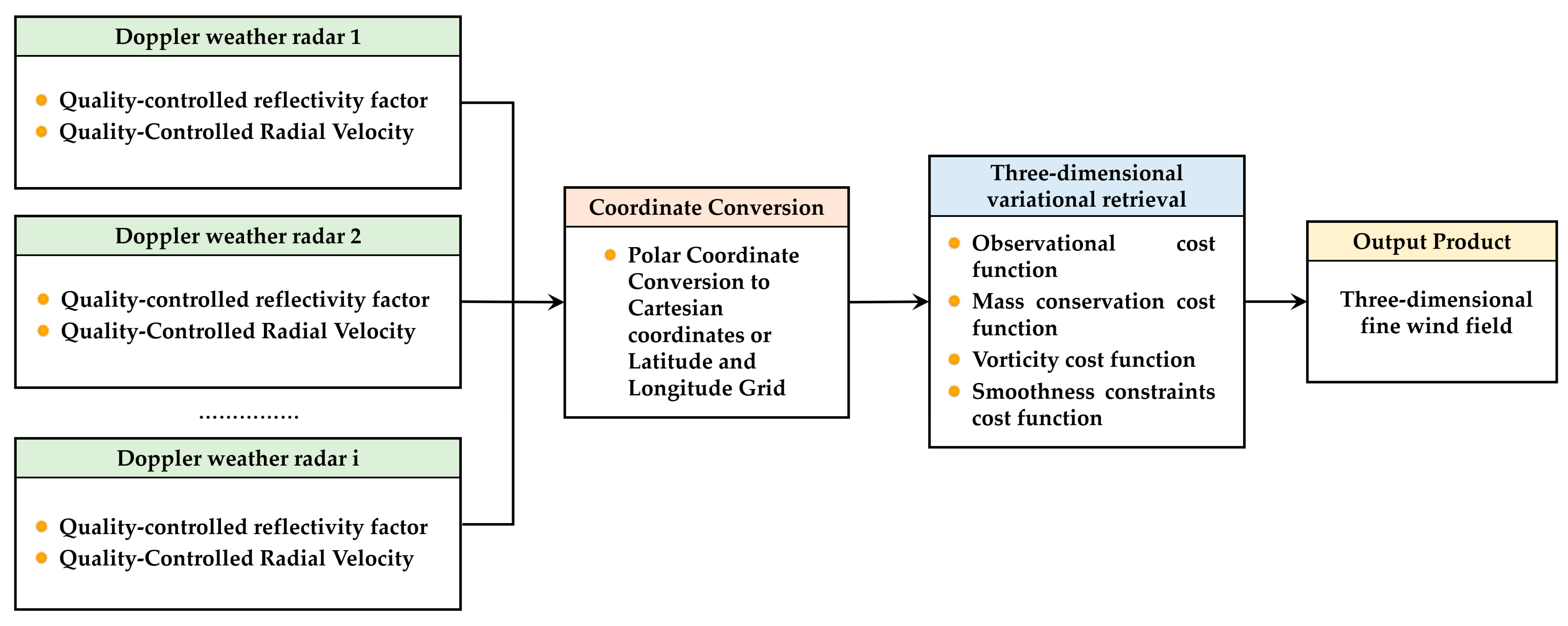
References
- Yin, J.F.; Gu, H.D.; Liang, X.; Yu, M.; Sun, J.S.; Xie, Y.X.; Li, F.; Wu, C. A possible dynamic mechanism for rapid production of the extreme hourly rainfall in Zhengzhou City on 20 July 2021. J. Meteorol. Res. 2023, 6, 6–25. [Google Scholar] [CrossRef]
- Su, A.F.; Lv, X.N.; Cui, L.M.; Li, Z.; Xi, L.; Li, H. The basic observational analysis of “7.20” extreme rainstorm in Zhengzhou. Torr. Rain Dis. 2021, 40, 445–454. (In Chinese) [Google Scholar] [CrossRef]
- Chen, G.; Zhao, K.; Lu, Y.H.; Zheng, Y.Y.; Xue, M.; Tan, Z.M.; Xu, X.; Huang, H.; Chen, H.N.; Xu, F.; et al. Variability of Microphysical Characteristics in the “21·7” Henan Extremely Heavy Rainfall Event. Sci. China Earth Sci. 2022, 65, 1861–1878. [Google Scholar] [CrossRef]
- Fu, S.M.; Zhang, Y.C.; Wang, H.J.; Tang, H.; Li, W.L.; Sun, J.H. On the Evolution of a Long-Lived Mesoscale Convective Vortex That Acted as a Crucial Condition for the Extremely Strong Hourly Precipitation in Zhengzhou. J. Geophys. Res. Atmos. 2022, 127, e2021JD036233. [Google Scholar] [CrossRef]
- Sun, J.H.; Fu, S.M.; Wang, H.J.; Zhang, Y.C.; Chen, Y.; Su, A.F.; Wang, Y.Q.; Tang, H.; Ma, R.Y. Primary Characteristics of the Extreme Heavy Rainfall Event over Henan in July 2021. Atmos. Sci. Lett. 2023, 24, e1131. [Google Scholar] [CrossRef]
- Chyi, D.; He, L.F.; Wang, X.M.; Chen, S. Fine observation characteristics and thermodynamic mechanisms of extreme heavy rainfall in Henan on 20 July 2021. J. Appl. Meteorol. Sci. 2022, 33, 1–15. (In Chinese) [Google Scholar] [CrossRef]
- Ran, L.K.; Li, S.W.; Zhou, Y.S.; Yang, S.; Ma, S.P.; Zhou, K.; Shen, D.D.; Jiao, B.F.; Li, N. Observational Analysis of the Dynamic, Thermal, and Water Vapor Characteristics of the “7.20” Extreme Rainstorm Event in Henan Province, 2021. Chin. J. Atmos. Sci. 2021, 45, 1366–1383. (In Chinese) [Google Scholar]
- Sun, Y.; Xiao, H.; Yang, H.L.; Ding, J.F.; Fu, D.H.; Guo, X.L.; Feng, L. Analysis of Dynamic Conditions and Hydrometeor Transport of Zhengzhou Superheavy Rainfall Event on 20 July 2021 Based on Optical Flow Field of Remote Sensing Data. Chin. J. Atmos. Sci. 2021, 45, 1384–1399. (In Chinese) [Google Scholar] [CrossRef]
- Yin, L.; Ping, F.; Mao, J.H.; Jin, S.G. Analysis on Precipitation Efficiency of the “21.7” Henan Extremely Heavy Rainfall Event. Adv. Atmos. Sci. 2023, 40, 374–392. [Google Scholar] [CrossRef]
- Guo, H.H.; Wang, K. Analysis of the microphysical characteristics of the “7·20” extremely heavy rainfall in Zhengzhou based on dual-polarization radar and precipitation phenomenon instrument data. Trans. Atmos. Sci. 2023, 46, 713–724. (In Chinese) [Google Scholar] [CrossRef]
- Zhang, Q.; Luo, Y.; Tang, Y.; Xu, X.; Yu, S.; Wu, C. Cause-Effect Relationship between Meso-γ-Scale Rotation and Extreme Short-Term Precipitation: Observational Analyses at Minute and Sub-Kilometer Scales. J. Meteorol. Res. 2022, 36, 539–552. [Google Scholar] [CrossRef]
- Nielsen, E.R.; Russ, S.S. Dynamical Mechanisms Supporting Extreme Rainfall Accumulations in the Houston “Tax Day” 2016 Flood. Mon. Weather Rev. 2020, 148, 83–109. [Google Scholar] [CrossRef]
- Nielsen, E.R. Observations of Extreme Short-Term Precipitation Associated with Supercells and Mesovortices. Mon. Weather Rev. 2020, 148, 159–182. [Google Scholar] [CrossRef]
- Wu, B.; Wei, M.; Li, Y. Dual-Polarization Radar Observations of the Evolution of a Supercell Tornado and Analysis of the Echo Mechanisms. Atmosphere 2022, 13, 797. [Google Scholar] [CrossRef]
- Liou, Y.-C.; Chang, Y.-J. A Variational Multiple-Doppler Radar Three-Dimensional Wind Synthesis Method and its Impacts on Thermodynamic Retrieval. Mon. Weather Rev. 2009, 137, 3992–4010. [Google Scholar] [CrossRef]
- Chang, W.Y.; Lee, W.C.; Liou, Y.C. The Kinematic and Microphysical Characteristics and Associated Precipitation Efficiency of Subtropical Convection During Sowmex/Timrex. Mon. Weather Rev. 2015, 143, 317–340. [Google Scholar] [CrossRef]
- Bousquet, O.; Tabary, P.; Parent du Châtelet, J. Operational multiple-Doppler wind retrieval inferred from long-range radial velocity measurements. J. Appl. Meteorol. Climatol. 2008, 47, 2929–2945. [Google Scholar] [CrossRef]
- Murphy, T.A.; Knupp, K. An Analysis of Cold Season Supercell Storms Using the Synthetic Dual-Doppler Technique. Mon. Weather Rev. 2013, 141, 602–624. [Google Scholar] [CrossRef]
- Zhang, G.F. Weather Radar Polarimetry; CRC Press: Boca Raton, FL, USA, 2016; pp. 10–16. [Google Scholar]
- Ryzhkov, A.; Zhang, P.; Reeves, H.; Kumjian, M.; Tschallener, T.; Troemel, S.; Simmer, C. Quasi-vertical profiles—A new way to look at polarimetric radar data. J. Atmos. Ocean. Technol. 2016, 33, 551–562. [Google Scholar] [CrossRef]
- Kumjian, M.R.; Khain, A.P.; Benmoshe, N.; Ilotoviz, E.; Ryzhkov, A.V.; Phillips, V.T. The Anatomy and Physics of Zdr Columns: Investigating a Polarimetric Radar Signature with a Spectral Bin Microphysical Model. J. Appl. Meteorol. Climatol. 2014, 53, 1820–1843. [Google Scholar] [CrossRef]
- Chen, B.J.; Wang, J.; Gong, D.L. Raindrop Size Distribution in a Midlatitude Continental Squall Line Measured by Thies Optical Disdrometers over East China. J. Appl. Meteorol. Climatol. 2016, 55, 621–634. [Google Scholar] [CrossRef]
- Janapati, J.; Seela, B.K.; Lin, P.L.; Lee, M.T.; Joseph, E. Microphysical Features of Typhoon and Non-Typhoon Rainfall Observed in Taiwan, an Island in the Northwestern Pacific. Hydrol. Earth Syst. Sci. 2021, 25, 4025–4040. [Google Scholar] [CrossRef]
- Wu, B.; Wang, D.D.; Li, Y.F.; Yin, H.; Du, S.; Li, P.H. A Comprehensive Observational Analysis for the Effects of Gas Cannons on Clouds and Precipitation. J. Trop. Meteorol. 2022, 28, 237–251. [Google Scholar] [CrossRef]
- Bringi, V.N.; Chandrasekar, V.; Hubbert, J.; Gorgucci, E.; Randeu, W.L.; Schoenhuber, M. Raindrop Size Distribution in Different Climatic Regimes from Disdrometer and Dual-Polarized Radar Analysis. J. Atmos. Sci. 2003, 60, 354–365. [Google Scholar] [CrossRef]
- Tang, Q.; Xiao, H.; Guo, C.W.; Feng, L. Characteristics of the Raindrop Size Distributions and Their Retrieved Polarimetric Radar Parameters in Northern and Southern China. Atmos. Res. 2014, 135–136, 59–75. [Google Scholar] [CrossRef]
- Ma, Y.; Ni, G.; Chandra, C.V.; Tian, F.; Chen, H. Statistical Characteristics of Raindrop Size Distribution During Rainy Seasons in the Beijing Urban Area and Implications for Radar Rainfall Estimation. Hydrol. Earth Syst. Sci. 2019, 23, 4153–4170. [Google Scholar] [CrossRef]
- Wen, L.; Zhao, K.; Zhang, G.F.; Xue, M.; Zhou, B.; Liu, S.; Chen, X.C. Statistical Characteristics of Raindrop Size Distributions Observed in East China During the Asian Summer Monsoon Season Using 2-D Video Disdrometer and Micro Rain Radar Data. J. Geophys. Res. Atmos. 2016, 121, 2265–2282. [Google Scholar] [CrossRef]
- DeHart, J.C.; Michael, M.B. A Comparison of the Polarimetric Radar Characteristics of Heavy Rainfall from Hurricanes Harvey (2017) and Florence (2018). J. Geophys. Res. Atmos. 2020, 125, e2019JD032212. [Google Scholar] [CrossRef]
- Han, B.; Du, Y.; Wu, C.; Liu, X. Microphysical Characteristics of the Coexisting Frontal and Warm-Sector Heavy Rainfall in South China. J. Geophys. Res. Atmos. 2021, 126, e2021JD035446. [Google Scholar] [CrossRef]
- Wu, B.; Wei, M.; Li, Y.; Wang, Z.; Du, S.; Zhao, C. Analysis of the Characteristics and Evolution Mechanisms of a Bow-Shaped Squall Line in East China Observed with Dual-Polarization Doppler Radars. Remote Sens. 2022, 14, 3531. [Google Scholar] [CrossRef]
- Maki, M.; Keenan, T.D.; Sasaki, Y.; Nakamura, K. Characteristics of the Raindrop Size Distribution in Tropical Continental Squall Lines Observed in Darwin, Australia. J. Appl. Meteorol. 2001, 40, 1393–1412. [Google Scholar] [CrossRef]
- Li, H.; Moisseev, D.; Luo, Y.; Liu, L.; Ruan, Z.; Cui, L.; Bao, X. Assessing Specific Differential Phase KDP -Based Quantitative Precipitation Estimation for the Record-Breaking Rainfall over Zhengzhou City on 20 July 2021. Hydrol. Earth Syst. Sci. 2023, 27, 1033–1046. [Google Scholar] [CrossRef]
- Zhang, J.; Tang, L.; Cocks, S.; Zhang, P.F.; Ryzhkov, A.; Howard, K.; Langston, C.; Kaney, B. A Dual-Polarization Radar Synthetic QPE for Operations. J. Hydrometeorol. 2020, 21, 2507–2521. [Google Scholar] [CrossRef]
- Zhang, Z.; Qi, Y.C.; Li, D.H.; Zhao, Z.F.; Cui, L.M.; Su, A.F.; Wang, X.M. Raindrop Size Distribution Characteristics of the Extreme Rainstorm Event in Zhengzhou 20 July, 2021 and Its Impacts on Radar Quantitative Precipitation Estimation. Chin. J. Atmos. Sci. 2022, 46, 1002–1016. (in Chinese). [Google Scholar] [CrossRef]
- Brown, B.R.; Bell, M.M.; Frambach, A.J. Validation of Simulated Hurricane Drop Size Distributions Using Polarimetric Radar. Geophys. Res. Lett. 2016, 43, 910–917. [Google Scholar] [CrossRef]
- Zhang, D.L.; Lin, Y.H.; Zhao, P.; Yu, X.D.; Wang, S.Q.; Hongwen Kang, H.W.; Ding, Y.H. The Beijing Extreme Rainfall of 21 July 2012: “Right Results” but for Wrong Reasons. Geophys. Res. Lett. 2013, 40, 1426–1431. [Google Scholar] [CrossRef]
- Houze, R.A. Orographic Effects on Precipitating Clouds. Rev. Geophys. 2012, 50, RG1001. [Google Scholar] [CrossRef]
- Bringi, V.; Chandrasekar, V. Polarimetric Doppler Weather Radar. Principles and Applications; Cambridge University Press: Cambridge, UK, 2001; pp. 378–531. [Google Scholar]
- Wen, J.; Zhao, K.; Huang, H.; Zhou, B.W.; Yang, Z.L.; Chen, G.; Wang, M.J.; Wen, L.; Dai, H.N.; Xu, L.L.; et al. Evolution of Microphysical Structure of a Subtropical Squall Line Observed by a Polarimetric Radar and a Disdrometer During Opacc in Eastern China. J. Geophys. Res. Atmos. 2017, 122, 8033–8050. [Google Scholar] [CrossRef]
- Zhang, J.; Wang, S.X. An Automated 2D Multipass Doppler Radar Velocity Dealiasing Scheme. J. Atmos. Ocean. Technol. 2006, 23, 1239–1248. [Google Scholar] [CrossRef]
- Shapiro, A.; Potvin, C.K.; Gao, J.D. Use of a Vertical Vorticity Equation in Variational Dual-Doppler Wind Analysis. J. Atmos. Ocean. Technol. 2009, 26, 2089–2106. [Google Scholar] [CrossRef]
- Potvin, C.K.; Shapiro, A.; Xue, M. Impact of a Vertical Vorticity Constraint in Variational Dual-Doppler Wind Analysis: Tests with Real and Simulated Supercell Data. J. Atmos. Ocean. Technol. 2012, 29, 32–49. [Google Scholar] [CrossRef]
- Löffler-Mang, M.; Joss, J. An Optical Disdrometer for Measuring Size and Velocity of Hydrometeors. J. Atmos. Ocean. Technol. 2000, 17, 130–139. [Google Scholar] [CrossRef]
- Friedrich, K.; Higgins, S.; Masters, F.J.; Lopez, C.R. Articulating and Stationary Parsivel Disdrometer Measurements in Conditions with Strong Winds and Heavy Rainfall. J. Atmos. Ocean. Technol. 2013, 30, 2063–2080. [Google Scholar] [CrossRef]
- Tokay, A.; Bashor, P.G. An Experimental Study of Small-Scale Variability of Raindrop Size Distribution. J. Appl. Meteorol. Climatol. 2010, 49, 2348–2365. [Google Scholar] [CrossRef]
- Guyot, A.; Pudashine, J.; Protat, A.; Uijlenhoet, R.; Pauwels, V.; Seed, A.; Walker, J. Effect of Disdrometer Type on Rain Drop Size Distribution Characterisation: A New Dataset for South-Eastern Australia. Hydrol. Earth Syst. Sci. 2019, 23, 4737–4761. [Google Scholar] [CrossRef]
- Brandes, E.A.; Zhang, G.F.; Vivekanandan, J. Drop Size Distribution Retrieval with Polarimetric Radar: Model and Application. J. Appl. Meteorol. 2004, 43, 461–475. [Google Scholar] [CrossRef]
- Gorgucci, E.; Chandrasekar, V.; Bringi, V.N.; Scarchilli, G. Estimation of Raindrop Size Distribution Parameters from Polarimetric Radar Measurements. J. Atmos. Sci. 2002, 59, 2373–2384. [Google Scholar] [CrossRef]
- Ulbrich, C.W. Natural Variations in the Analytical Form of the Raindrop Size Distribution. J. Appl. Meteorol. Climatol. 1983, 22, 1764–1775. [Google Scholar] [CrossRef]
- Zhang, G.F.; Vivekanandan, J.; Brandes, E. A method for estimating rain rate and drop size distribution from polarimetric radar measurements. IEEE Trans. Geosci. Remote Sens. 2001, 39, 830–841. [Google Scholar] [CrossRef]
- Brandes, E.A.; Zhang, G.; Vivekanandan, J. Experiments in rainfall estimation with a polarimetric radar in a subtropical environment. J. Appl. Meteorol. 2002, 41, 674–685. [Google Scholar] [CrossRef]
- Luo, Y.H.; Du, Y. The Roles of Low-Level Jets in “21·7” Henan Extremely Persistent Heavy Rainfall Event. Adv. Atmos. Sci. 2023, 40, 350–373. [Google Scholar] [CrossRef]
- Kumjian, M.R.; Mishra, S.; Giangrande, S.E.; Toto, T.; Ryzhkov, A.V.; Bansemer, A. Polarimetric Radar and Aircraft Observations of Saggy Bright Bands During MC3E. J. Geophys. Res. Atmos. 2016, 121, 3584–3607. [Google Scholar] [CrossRef]
- Zawadzki, I.; Szyrmer, W.; Bell, C.; Fabry, F. Modeling of the Melting Layer. Part III: The Density Effect. J. Atmos. Sci. 2005, 62, 3705–3723. [Google Scholar] [CrossRef]
- Griffin, E.M.; Schuur, T.J.; Ryzhkov, A.V. A Polarimetric Radar Analysis of Ice Microphysical Processes in Melting Layers of Winter Storms Using S-Band Quasi-Vertical Profiles. J. Appl. Meteorol. Climatol. 2020, 59, 751–767. [Google Scholar] [CrossRef]
- Carlin, J.T.; Ryzhkov, A.V. Estimation of Melting-Layer Cooling Rate from Dual-Polarization Radar: Spectral Bin Model Simulations. J. Appl. Meteorol. Climatol. 2019, 58, 1485–1508. [Google Scholar] [CrossRef]
- Li, H.; Tiira, J.; Lerber, A.V.; Moisseev, D. Towards the Connection between Snow Microphysics and Melting Layer: Insights from Multifrequency and Dual-Polarization Radar Observations During BAECC. Atmos. Chem. Phys. 2020, 20, 9547–9562. [Google Scholar] [CrossRef]
- Carr, N.; Kirstetter, P.E.; Gourley, J.J.; Hong, Y. Polarimetric Signatures of Midlatitude Warm-Rain Precipitation Events. J. Appl. Meteorol. Climatol. 2017, 56, 697–711. [Google Scholar] [CrossRef]
- Homeyer, C.R.; Fierro, A.O.; Schenkel, B.A.; Didlake, A.C.; McFarquhar, G.M.; Hu, J.X.; Ryzhkov, A.V.; Basara, J.B.; Murphy, A.M.; Zawislak, J. Polarimetric Signatures in Landfalling Tropical Cyclones. Mon. Weather Rev. 2021, 149, 131–154. [Google Scholar] [CrossRef]
- Von Terzi, L.; Neto, J.D.; Ori, D.; Myagkov, A.; Kneifel, S. Ice Microphysical Processes in the Dendritic Growth Layer: A Statistical Analysis Combining Multi-Frequency and Polarimetric Doppler Cloud Radar Observations. Atmos. Chem. Phys. 2022, 22, 11795–11821. [Google Scholar] [CrossRef]
- Chandrasekar, V.; Beauchamp, R.M.; Bechini, R. Introduction to Dual Polarization Weather Radar; Cambridge University Press: New York, NY, USA, 2023; pp. 445–451. [Google Scholar] [CrossRef]
- Cressman, G.P. An operational objective analysis system. Mon. Weather Rev. 1959, 87, 367–374. [Google Scholar] [CrossRef]
- Barnes, S.L. A technique for maximizing details in numerical weather map analysis. J. Appl. Meteorol. 1964, 3, 396–409. [Google Scholar] [CrossRef]
- Askelson, M.A.; Aubagnac, J.-P.; Straka, J.M. An adaptation of the Barnes filter applied to the objective analysis of radar data. Mon. Weather Rev. 2000, 128, 3050–3082. [Google Scholar] [CrossRef]
- Shapiro, A.; Ellis, S.; Shaw, J. Single-Doppler Velocity Retrievals with Phoenix II Data: Clear Air and Microburst Wind Re-trievals in the Planetary Boundary Layer. J. Atmos. Sci. 1995, 52, 1265–1287. [Google Scholar] [CrossRef]
- Potvin, C.; Betten, D.; Wicker, L.; Elmore, K.; Biggerstaff, M. 3DVAR versus Traditional Dual-Doppler Wind Retrievals of a Simulated Supercell Thunderstorm. Mon. Weather Rev. 2012, 140, 3487–3494. [Google Scholar] [CrossRef]
- Peskin, C. Flow Patterns around Heart Valves: A Numerical Method. J. Comput. Phys. 1972, 10, 252–271. [Google Scholar] [CrossRef]
- Liou, Y.C.; Chang, S.F.; Sun, J. An Application of the Immersed Boundary Method for Recovering the Three-Dimensional Wind Fields over Complex Terrain Using Multiple-Doppler Radar Data. Mon. Weather Rev. 2012, 140, 1603–1619. [Google Scholar] [CrossRef]
- Bell, M.; Montgomery, M.; Emanuel, K. Air–Sea Enthalpy and Momentum Exchange at Major Hurricane Wind Speeds Observed During Cblast. J. Atmos. Sci. 2012, 69, 3197–3222. [Google Scholar] [CrossRef]
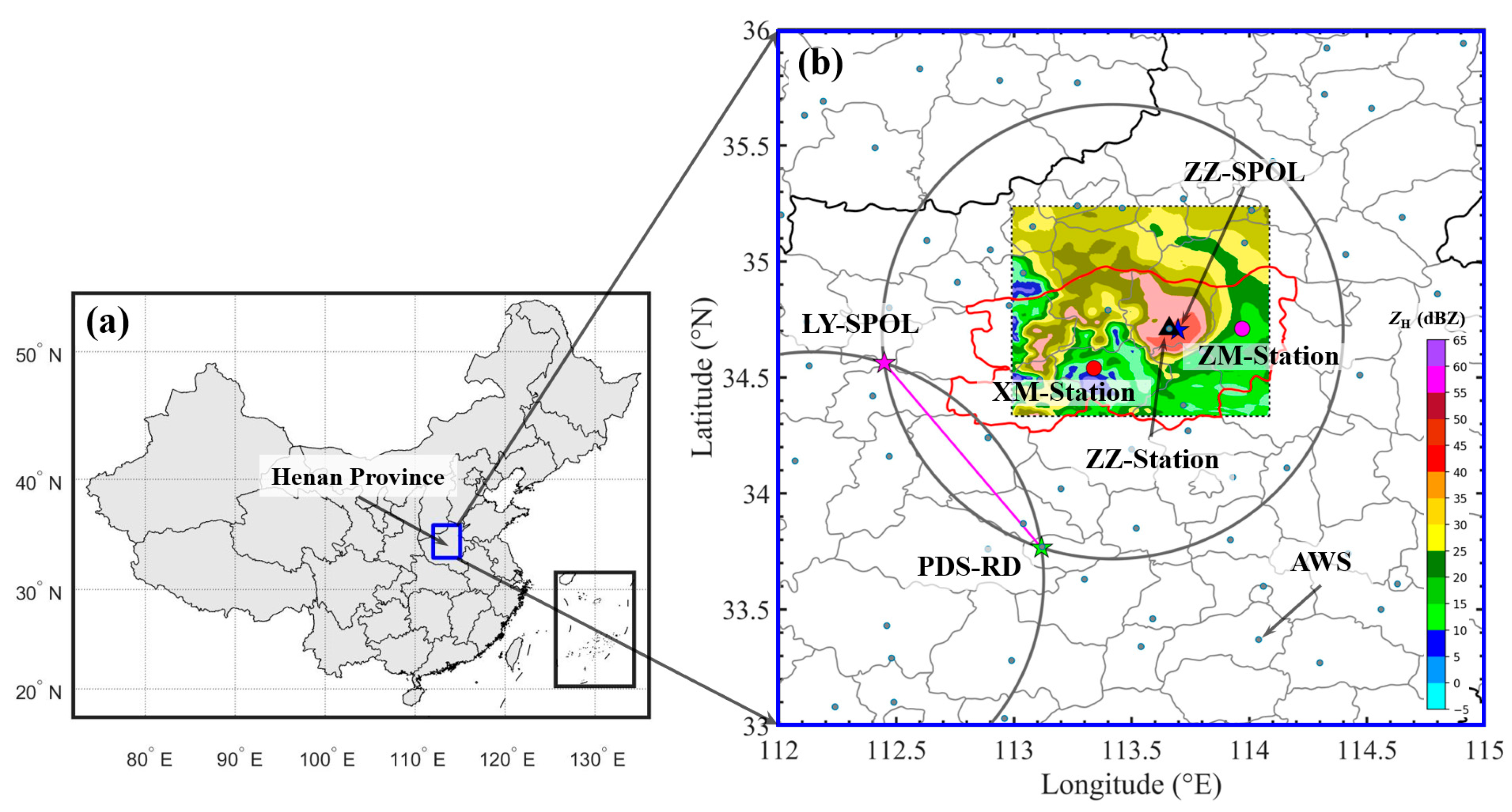
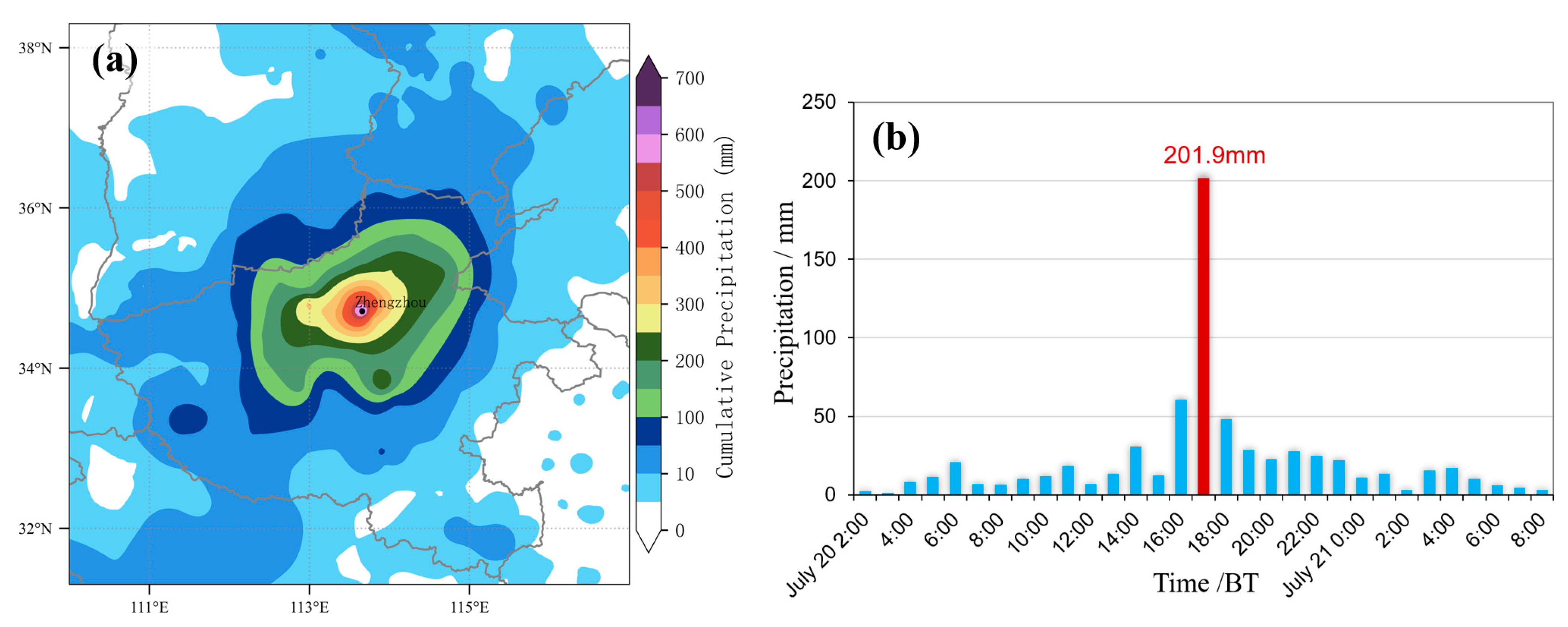
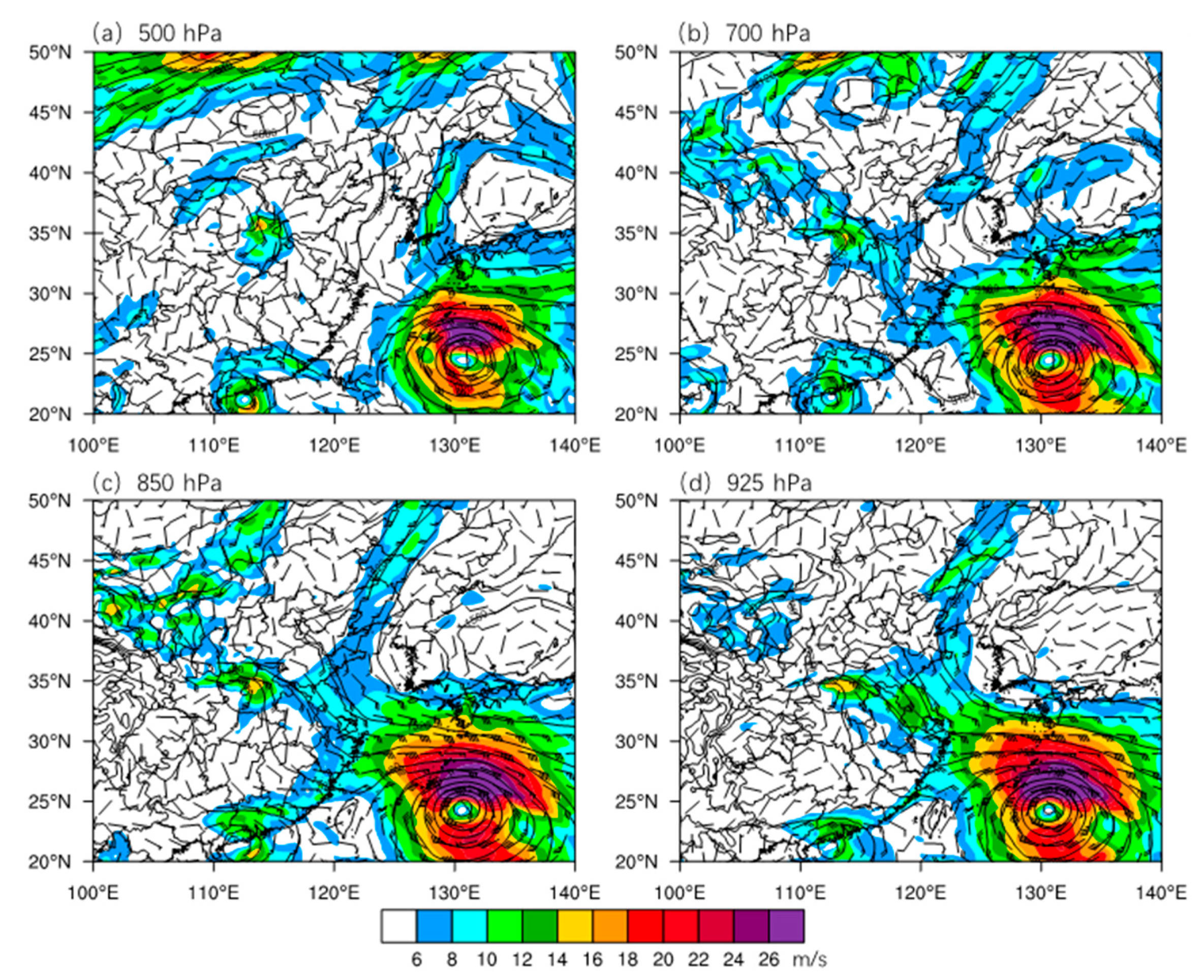
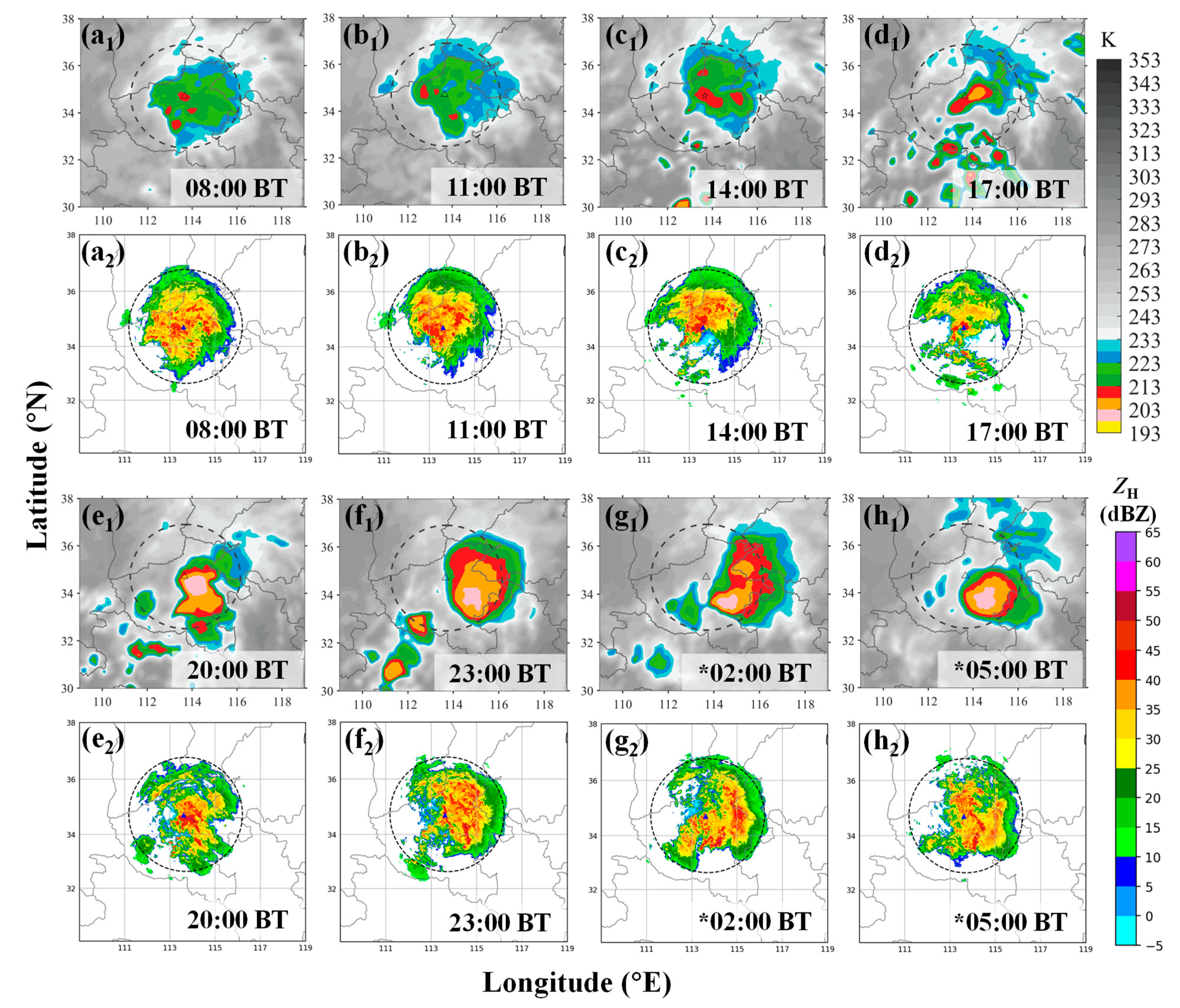


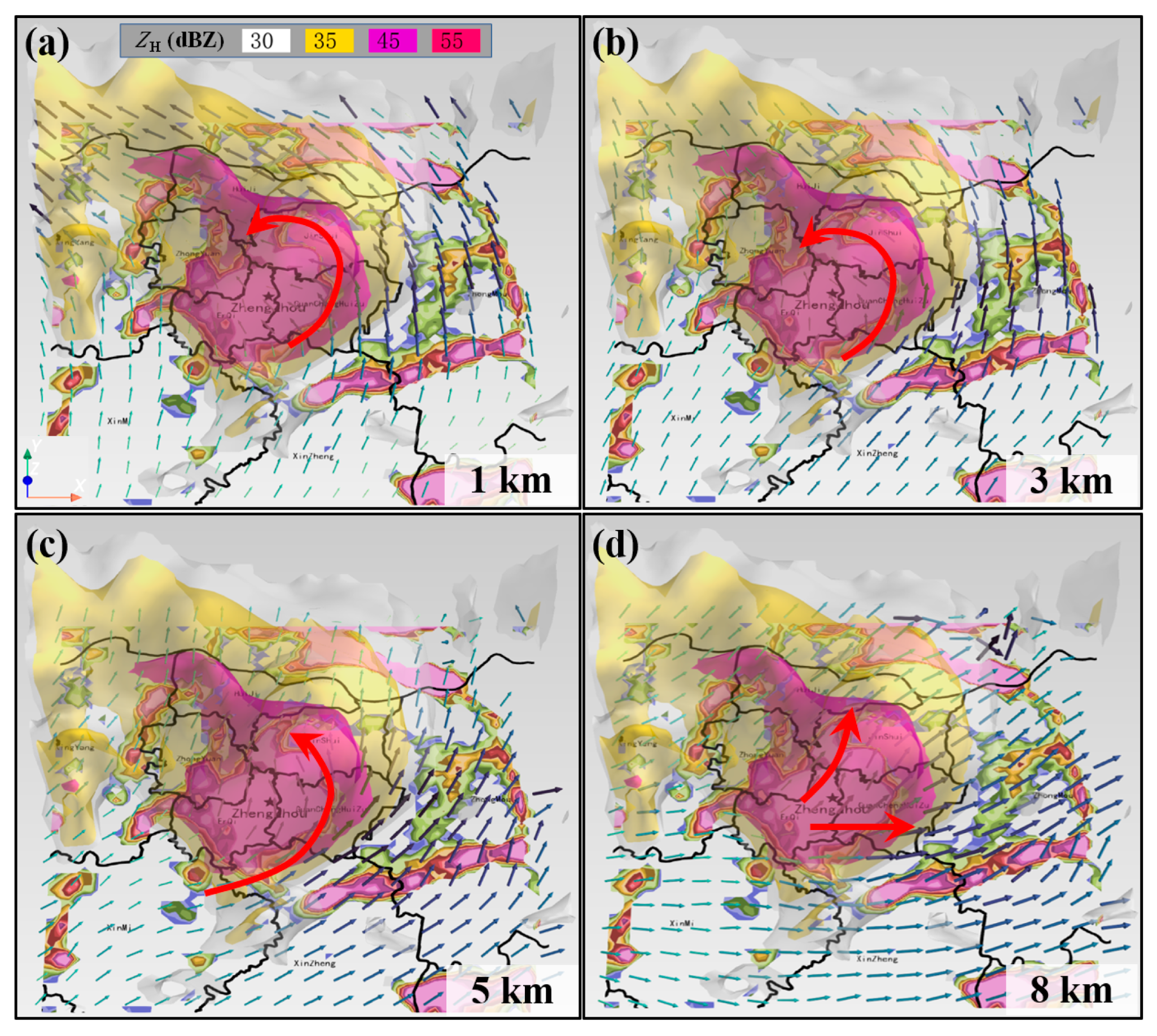
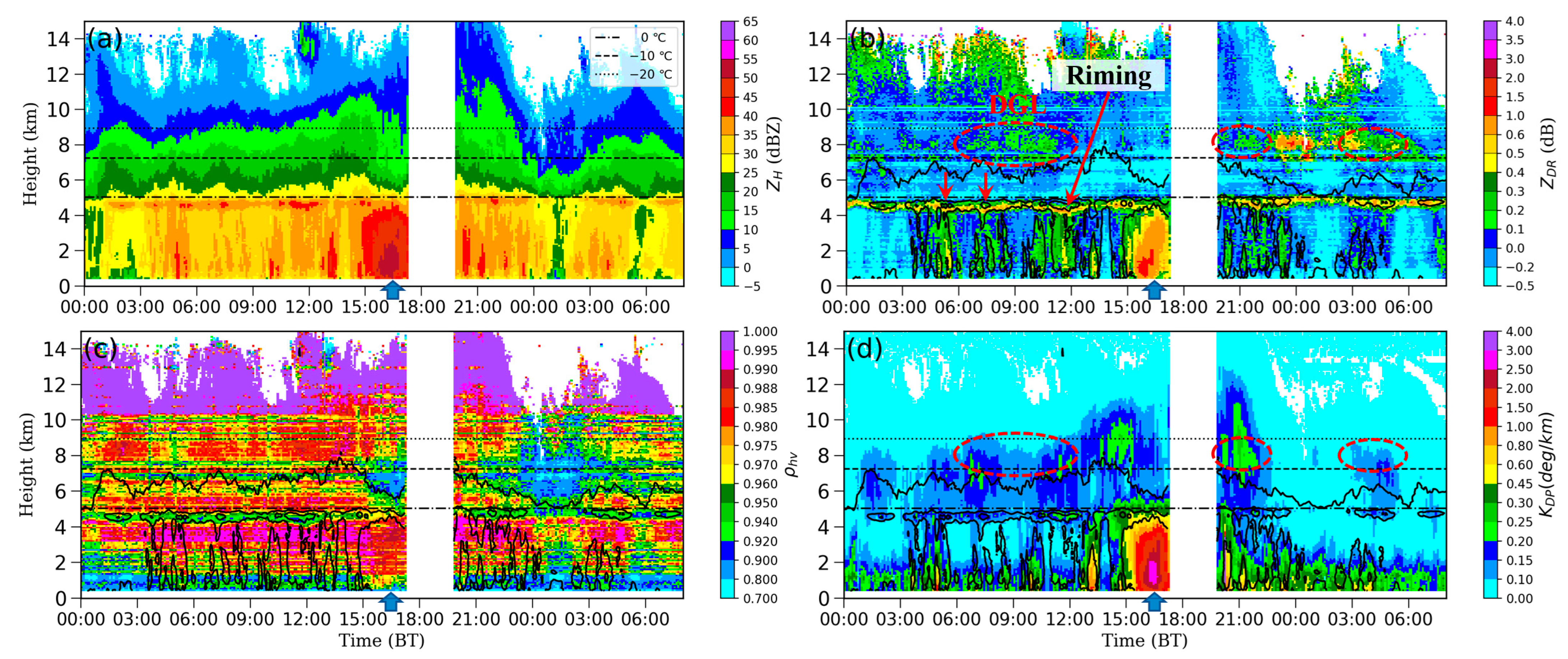
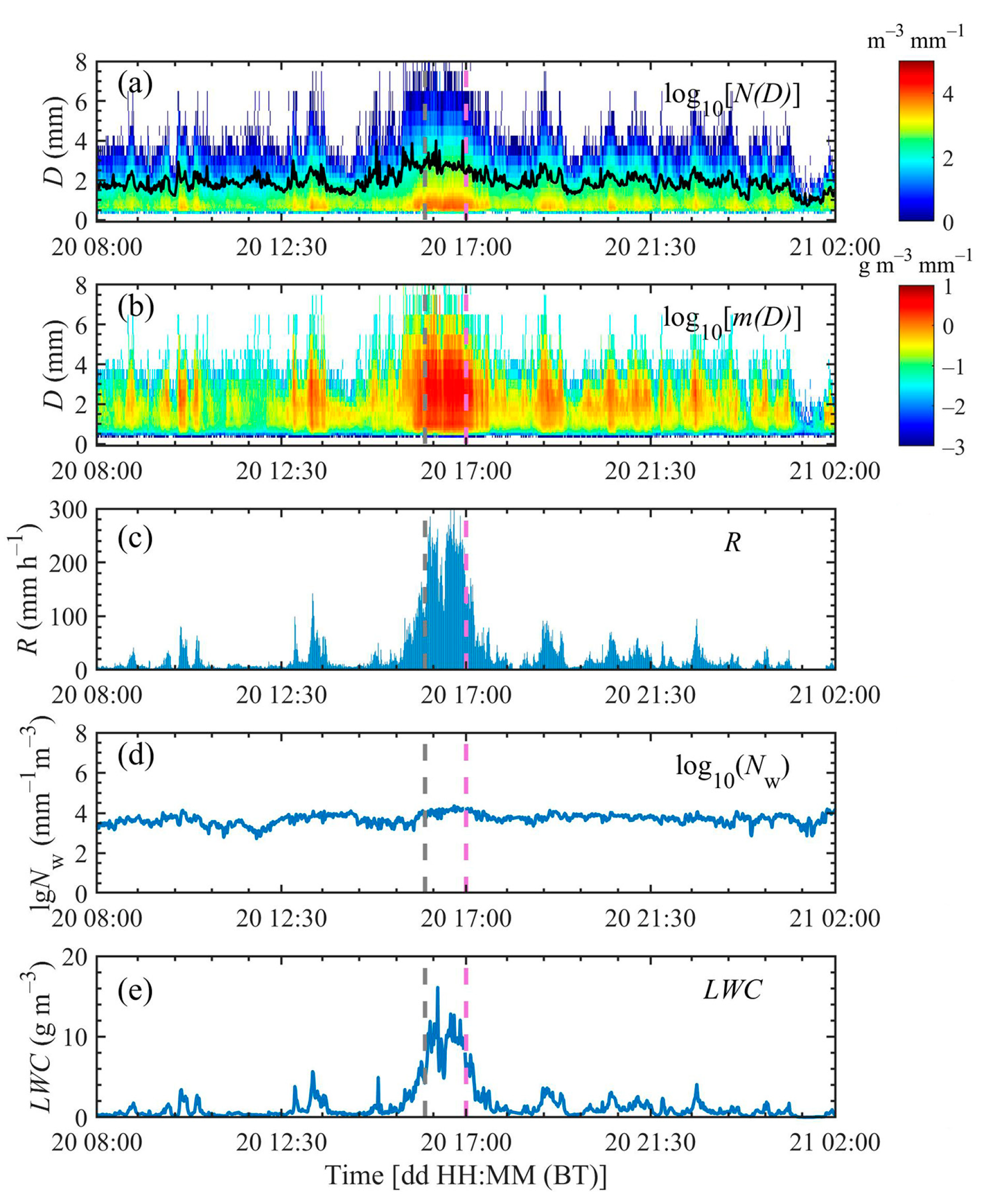
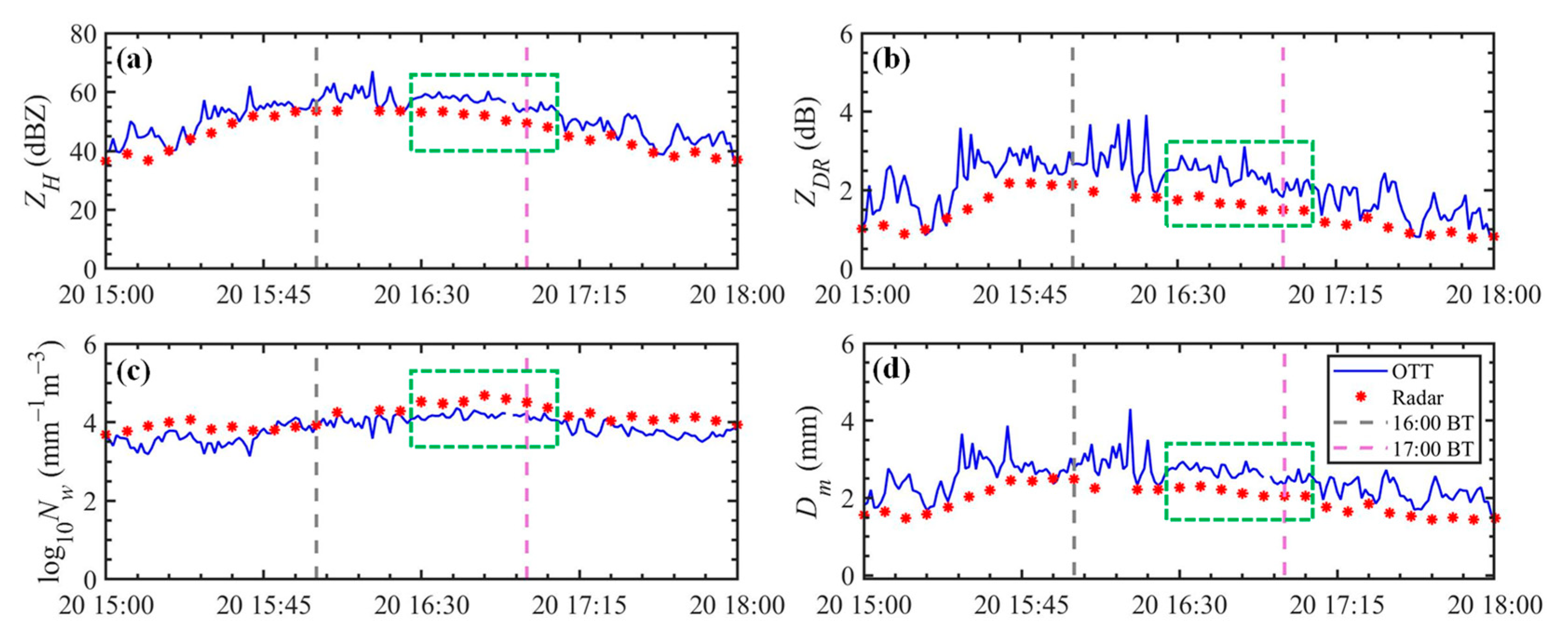
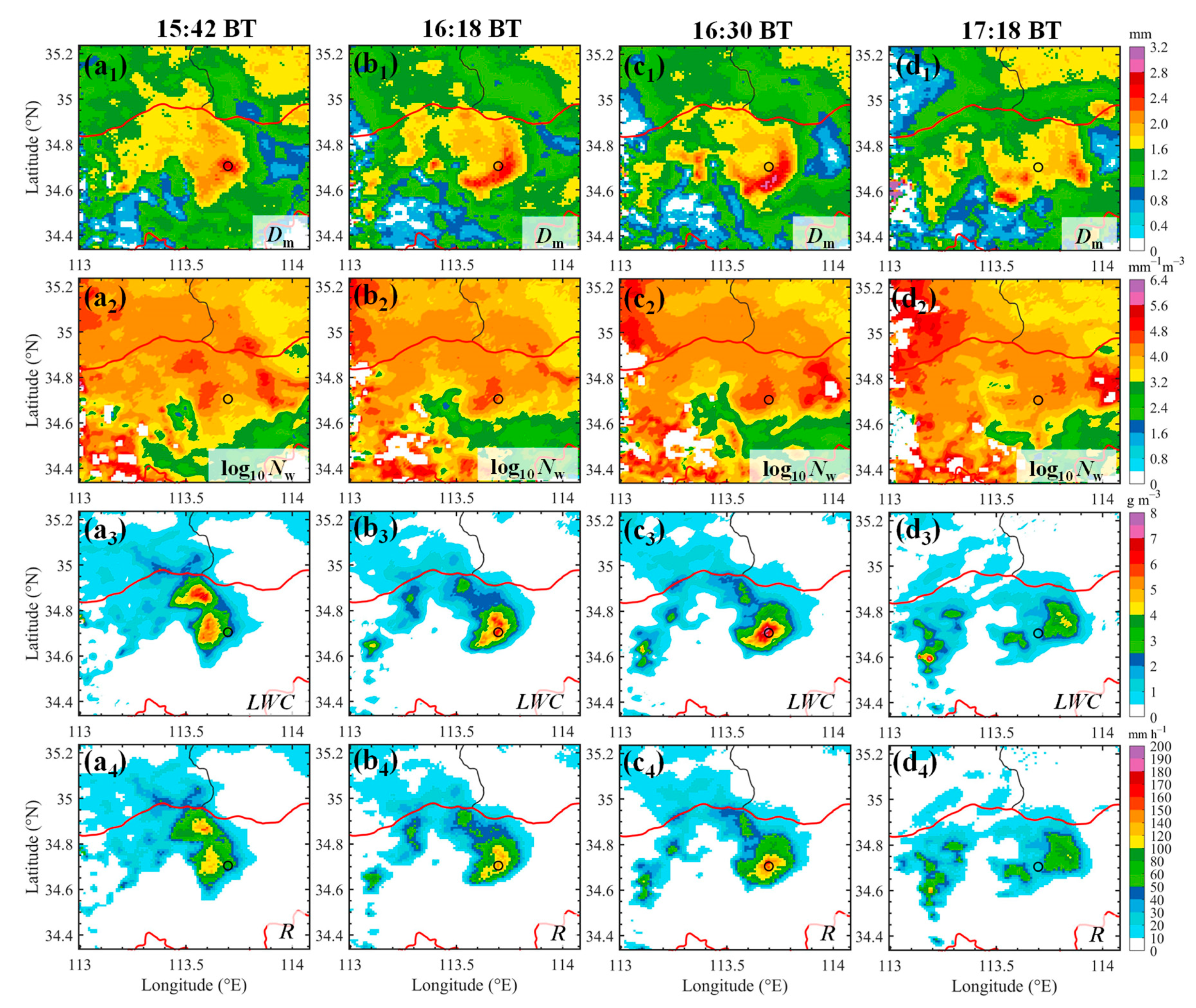

| PDS-RD | ZZ-SPOL + | LY-SPOL + | |
|---|---|---|---|
| Wavelength (cm) | 10 | 10 | 10 |
| Peak power (kW) | 700 | 700 | 700 |
| PRF (Hz) * | 322~1304 | 322~1304 | 322~1304 |
| Pulse width (μs) | 1.57, 4.7 | 1.57, 4.7 | 1.57, 4.7 |
| Antenna gain (dB) | 45.5 | 44.82 | 44.82 |
| Data range resolution (m) | ZH: 1000; V, W: 250 | ZH, Vr: 250 | ZH, Vr: 250 |
| Azimuthal resolution (°) | 1.0 | 1.0 | 1.0 |
| Horizontal beamwidth (°) | 0.93 | 0.99 | 0.99 |
| Vertical beamwidth (°) | — | 0.93 | 0.93 |
| Scan properties | 9 elevation angles (0.5°–19.5°) in 6 min | 9 elevation angles (0.5°–19.5°) in 6 min | 9 elevation angles (0.5°–19.5°) in 6 min |
Disclaimer/Publisher’s Note: The statements, opinions and data contained in all publications are solely those of the individual author(s) and contributor(s) and not of MDPI and/or the editor(s). MDPI and/or the editor(s) disclaim responsibility for any injury to people or property resulting from any ideas, methods, instructions or products referred to in the content. |
© 2023 by the authors. Licensee MDPI, Basel, Switzerland. This article is an open access article distributed under the terms and conditions of the Creative Commons Attribution (CC BY) license (https://creativecommons.org/licenses/by/4.0/).
Share and Cite
Wu, B.; Du, S.; Li, W.; Shen, Y.; Luo, L.; Li, Y.; Wei, M.; Wang, D.; Xi, L. The Kinematic and Microphysical Characteristics of Extremely Heavy Rainfall in Zhengzhou City on 20 July 2021 Observed with Dual-Polarization Radars and Disdrometers. Remote Sens. 2023, 15, 5688. https://doi.org/10.3390/rs15245688
Wu B, Du S, Li W, Shen Y, Luo L, Li Y, Wei M, Wang D, Xi L. The Kinematic and Microphysical Characteristics of Extremely Heavy Rainfall in Zhengzhou City on 20 July 2021 Observed with Dual-Polarization Radars and Disdrometers. Remote Sensing. 2023; 15(24):5688. https://doi.org/10.3390/rs15245688
Chicago/Turabian StyleWu, Bin, Shuang Du, Wenjuan Li, Yian Shen, Ling Luo, Yanfang Li, Ming Wei, Dandan Wang, and Lei Xi. 2023. "The Kinematic and Microphysical Characteristics of Extremely Heavy Rainfall in Zhengzhou City on 20 July 2021 Observed with Dual-Polarization Radars and Disdrometers" Remote Sensing 15, no. 24: 5688. https://doi.org/10.3390/rs15245688
APA StyleWu, B., Du, S., Li, W., Shen, Y., Luo, L., Li, Y., Wei, M., Wang, D., & Xi, L. (2023). The Kinematic and Microphysical Characteristics of Extremely Heavy Rainfall in Zhengzhou City on 20 July 2021 Observed with Dual-Polarization Radars and Disdrometers. Remote Sensing, 15(24), 5688. https://doi.org/10.3390/rs15245688




